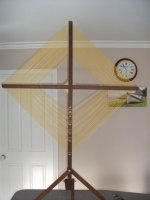Hi "C"
I am not quite sure what your purpose in building a low power BC band transmitter is. Is there an end purpose or just to experiment ??
If its an experiment, you may find that you are not alone -- I have known a few hams that have taken a (strange) pleasure in Part 15 BC Band transmitters and seeing just what they can achieve under some really severe restrictions. But fortunately the laws about this section of Part 15 were written Lonnnng ago and are quite easy for an experimenter to adhere to.
(
a) The total input power to the final radio frequency stage (exclusive of filament or heater power)** shall not exceed 100 milliwatts.
(b) The total length of the transmission line, antenna and ground lead (if used) shall not exceed 3 meters.
(c) All emissions below 510 kHz or above 1705 kHz shall be attenuated at least 20 dB below the level of the unmodulated carrier. Determination of compliance with the 20 dB attenuation specification may be based on measurements at the intentional radiator's antenna output terminal unless the intentional radiator uses a permanently attached antenna, in which case compliance shall be deomonstrated by measuring the radiated emissions.
The fellows I know are all quite weird in their passion for these things radio-exotic (like my father)- but they've done some rather remarkable stuff under these challenges. (Why they just didn't do them in the 160 metre band is best left up to them to explain  .)
.)
______________________________________________________________________________________________________
**you can tell this provision has not been updated in years when it refers to "filament or heater power 
_____________________________________________________________________________________________________
That being said, choosing the right frequency in the BC band is paramount, but you are not restricted to any set 10 KHz standard broadcast channel. 1627 KHz is just fine, for example, if it puts you into the clear. And of course with the restrictions on antenna length you will want the high end of the band-- every little plus-- efficiency wise-- matters here.
With a top loaded 10 foot ("3 metre") antenna theses "BC'ers" fellows claim ranges measured in miles using simple homebrew'd double side transmitters and communication-grade receivers.
Remember too, that experimental designed, home constructed transmitters are perfectly Part 15 legal and do not have the same restrictions as if they are for commercial sale.
Technically the whole secret revolves around that old bugger that has been the fore-front of radio since Marconi---the antenna.
Now you are in for a whole lot of neat experimenting--
The successful designs tend to be top loaded verticals. Forget anything less---we are after vertical radiation, even for these toy-power transmitters-- and even here we are after a groundwave that can not be achieved with a horizontal radiator.
Its going to be another challenge to calculated the value of a 'top loading coil'-- but the biggest in diameter and most turns you can construct, plus a generous capacity 'hat' is a starting point. At the base use an LC matching network-- use a big air variable capacitor--- connected directly from the transmitter to the vertical pole..... the 1/2 inch copper pipe is good, a larger diameter is even better. And you want to mount this over the best ground system you can achieve... the rules leaves that vague just so long as that connection is part of your 10 feet.
As far as adjusting this beauty, use a field strength meter set as far from the antenna as you can get reasonable readings. You'll want a very sensitive meter, and of course tune for the best field strength.
Forget any SWR meters-- the power is too low and with this transmitter-so-short antenna it would be like trying to measure the SWR of a Tesla coil. An antenna tuner will be too loss-y as well.
Go for a big coil and a quality air variable in a parallel LC matching circuit right at the antenna's
base.
___________________________________________________________________________________________________________
This sounds like a fun project, one filled with some great learning potential.
If you can make this successful you can do do anything radio.
I would love to hear an epilogue

Lauri

.




